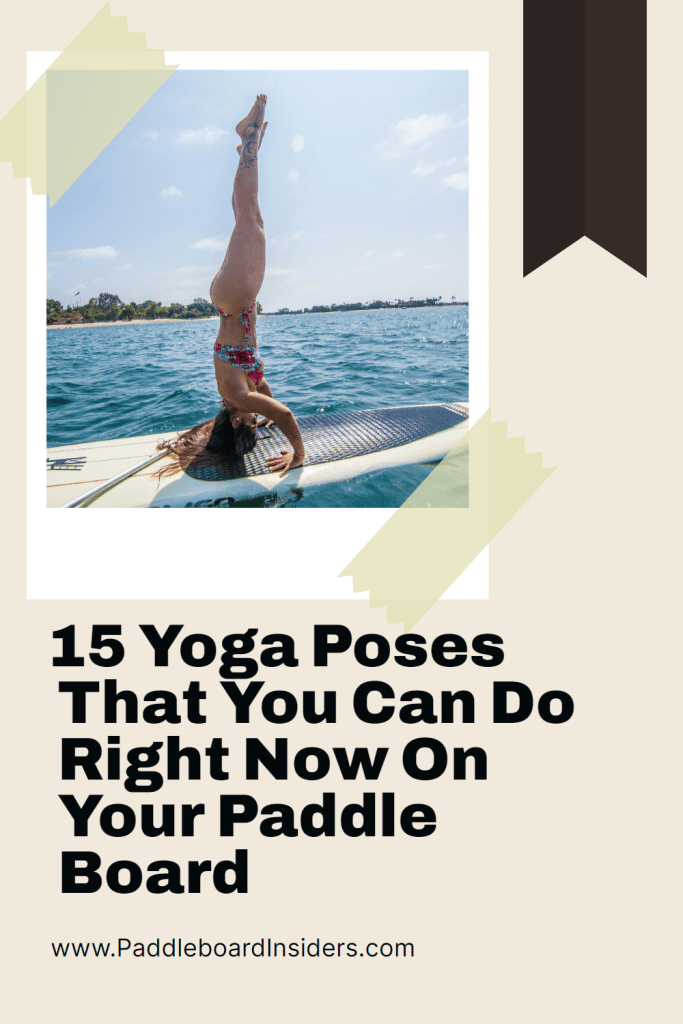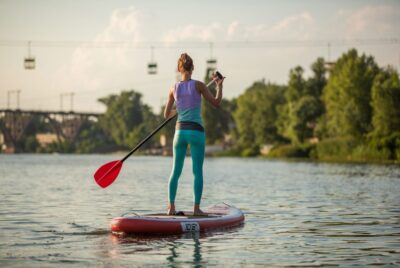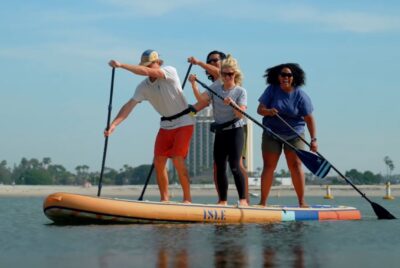15 Yoga Poses That You Can Do Right Now On Your Paddle Board (Step By Step Guide With Images)
*We may earn a commission for purchases made using our links. Please see our disclosure to learn more.
Practicing yoga on a paddleboard is taking the world by storm!
It enhances your practice and adds an extra element of challenge, connection with nature, and tranquility that you can’t find anywhere else.
In this article, I will share with you 15 yoga poses that you can do right now on a paddleboard. So grab your board, put on your favorite yoga gear, and let’s dive into the world of paddleboard yoga!
| Looking for our best paddle board product recommendations? Check the Paddleboard Insiders Buyer Guides |
Table Of Contents
- Introduction to Paddleboarding & Its Big Benefits
- Overview of Practicing Yoga on a Paddleboard
- Warm-up Exercises to Prepare the Body
- Yoga Poses for Balance and Stability on a Paddleboard
- Yoga Poses for Core Strength
- Yoga Poses for Relaxation and Rejuvenation
- Tips for Maintaining Balance and Stability During Yoga on a Paddleboard
- Benefits of Practicing Yoga on a Paddleboard
- My Favorite Paddleboards To Do Yoga On:
- Conclusion
- FAQs
- Can anyone practice yoga on a paddleboard, or is it only for experienced yogis?
- Do I need any special equipment for yoga on a paddleboard?
- How do I choose the right paddleboard for yoga?
- What if I fall into the water while practicing yoga on a paddleboard?
- Can I practice yoga on a paddleboard in any body of water?
Introduction to Paddleboarding & Its Big Benefits
Before we delve into the yoga poses, let’s first understand the basics of paddleboarding and the benefits it offers. Paddleboarding is a water sport that involves standing on a large surfboard and using a paddle to propel oneself through the water. It provides a full-body workout, improves balance and core strength, and allows you to enjoy the serenity of being out on the water.
Overview of Practicing Yoga on a Paddleboard
Yoga on a paddleboard takes the practice of yoga to a whole new level. It requires focus, stability, and a sense of adventure. Practicing yoga on a paddleboard not only challenges your physical abilities but also cultivates mindfulness and a deeper connection with the elements around you. The gentle movement of the water and the sounds of nature create a serene environment, allowing you to find inner peace and balance.
Preparation and Safety Tips Before Attempting Yoga on a Paddleboard
Before you jump into practicing yoga on a paddleboard, there are a few important things to consider. First and foremost, it’s essential to have a basic understanding of both paddleboarding and yoga. If you’re new to either activity, I recommend taking some lessons or practicing in a calm and shallow body of water.
Safety should always be a priority. Ensure that you wear a personal flotation device (PFD) and a leash that attaches you to the paddleboard. Choose a location with calm water and minimal boat traffic. It’s also a good idea to have a buddy or an instructor with you, especially if you’re a beginner.
Essential Equipment for Practicing Yoga on a Paddleboard
To have a comfortable and enjoyable paddleboard yoga experience, you’ll need some essential equipment. First, you’ll need a stable paddleboard specifically designed for yoga or with a wide deck for better balance. A non-slip deck pad will provide traction and prevent slipping. Additionally, invest in a lightweight and adjustable paddle that suits your height.
| Looking for more accessories for your paddle board? The 23 Best Paddleboard Accessories That You Need In 2025 |
Wearing the right attire is crucial. Opt for flexible and moisture-wicking clothing that allows for a full range of motion. Don’t forget to wear sunscreen and a hat to protect yourself from the sun’s rays. Lastly, keep a waterproof bag or container nearby to store your personal belongings and valuables.
Warm-up Exercises to Prepare the Body
Before starting the yoga poses, it’s essential to warm up your body and prepare it for the physical challenges ahead. Begin with gentle stretches to loosen up your muscles. Roll your shoulders, rotate your neck, and do some wrist and ankle circles. Incorporate dynamic movements like arm swings, hip circles, and gentle twists to increase blood flow and warm up your joints.
Now that your body is warm and ready, it’s time to move on to the yoga poses. Remember to take it slow, listen to your body, and make modifications as needed. Let’s dive into the 15 yoga poses that you can do on a paddleboard!
Yoga Poses for Balance and Stability on a Paddleboard
1. Mountain Pose (Tadasana)
Mountain Pose is the foundation of all standing yoga poses. It helps improve posture, balance, and stability. Begin by standing tall with your feet hip-width apart, toes pointing forward. Distribute your weight evenly across both feet, engage your core, and lengthen your spine. Relax your shoulders and extend your arms alongside your body, palms facing forward. Take deep breaths and focus on finding stability and grounding on your paddleboard.

Instructions:
1: Stand tall with your feet hip-width apart, toes pointing forward.
2: Distribute your weight evenly across both feet, engage your core, and lengthen your spine.
3: Relax your shoulders and extend your arms alongside your body, palms facing forward.
2. Tree Pose (Vrikshasana)
Tree Pose challenges your balance and strengthens your legs. Start by shifting your weight onto one foot while keeping the other foot lightly placed on your inner thigh or calf (avoid placing it on the knee joint). Bring your hands to prayer position in front of your chest or extend them overhead like branches of a tree. Find a fixed point in front of you to help maintain balance. Embrace the gentle swaying of the paddleboard and feel the connection with nature.

Instructions:
1: Shift your weight onto one foot while keeping the other foot lightly placed on your inner thigh or calf (avoid placing it on the knee joint).
2: Bring your hands to prayer position in front of your chest or extend them overhead like branches of a tree.
3: Find a fixed point in front of you to help maintain balance.
3. Warrior 1 (Virabhadrasana I)
Warrior I is a really great pose that opens the chest and lungs to enhance breating and build focus, power and stability. It stretches and strengthens the feet, calves, ankles and your quad muscles for a full body experience. Bend your front knee directly over your ankle while keeping your back leg straight. Extend your armsabove your head while gazing at your hands. Sink into the pose and feel the beautiful stretch through your entire body.
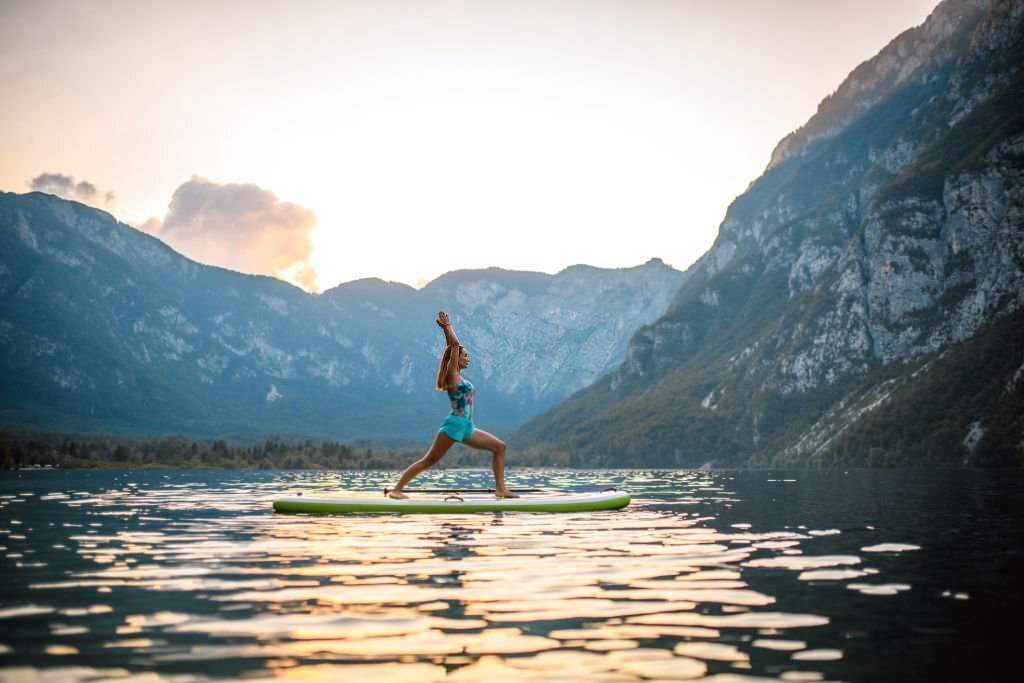
Instructions:
1: Step one foot forward and bend your front knee, ensuring it’s directly above your ankle.
2: Keep your back foot at a 45-degree angle and press the outer edge of the foot into the board.
3: Raise your arms overhead, reaching up toward the sky, and gaze forward.
4. Warrior II (Virabhadrasana II)
Warrior II is a powerful pose that promotes strength, stability, and focus. Begin by stepping your feet wide apart, with your front foot pointing forward and your back foot angled slightly inward. Bend your front knee directly over your ankle while keeping your back leg straight. Extend your arms out to the sides, parallel to the ground, with your gaze focused over your front hand. Sink deeper into the pose and feel your inner warrior emerge on the paddleboard.
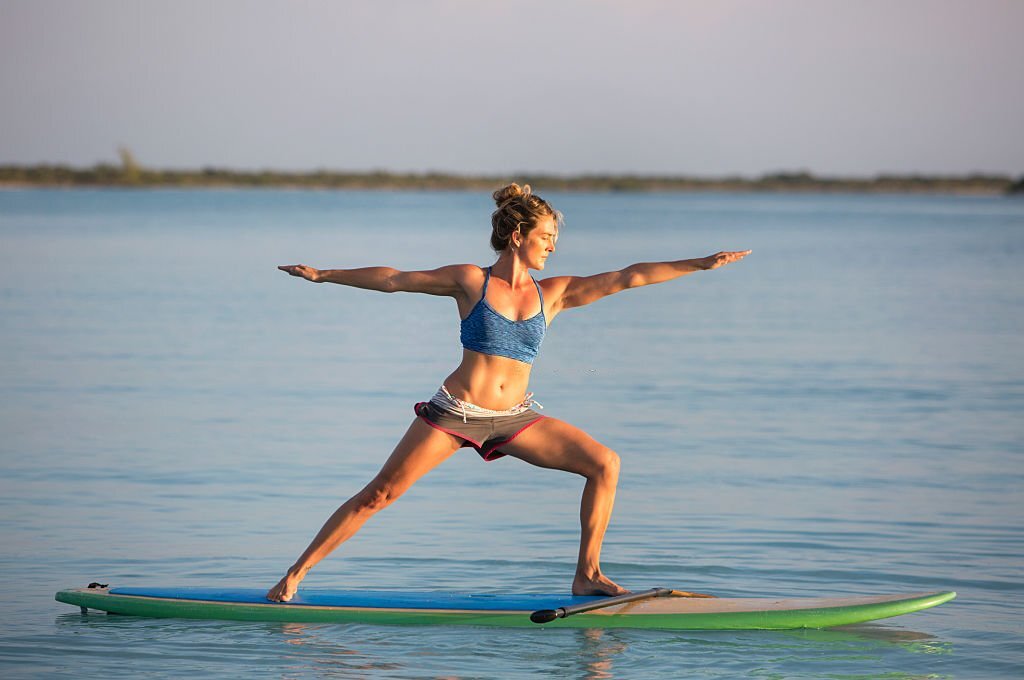
Instructions:
1: Step your feet wide apart, with your front foot pointing forward and your back foot angled slightly inward.
2: Bend your front knee directly over your ankle while keeping your back leg straight.
3: Extend your arms out to the sides, parallel to the ground, with your gaze focused over your front hand.
5. Extended Triangle Pose (Utthita Trikonasana)
Extended Triangle Pose stretches and strengthens the entire body. Start by stepping your feet wide apart, with your front foot pointing forward and your back foot angled inward. Extend your arms out to the sides, parallel to the ground. Reach forward with your front hand and hinge at the hip, placing your hand on your shin, ankle, or the paddleboard. Extend your other arm upward, creating a straight line from your fingertips to your back foot. Engage your core, open your chest, and enjoy the gentle breeze as you hold this pose.
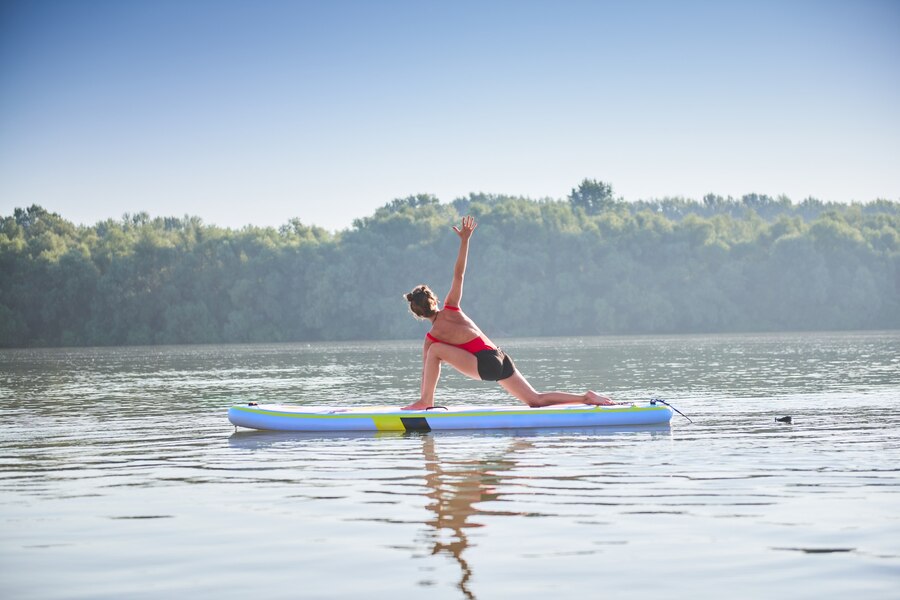
Instructions:
1: Step your feet wide apart, with your front foot pointing forward and your back foot angled inward.
2: Extend your arms out to the sides, parallel to the ground.
3: Reach forward with your front hand and hinge at the hip, placing your hand on your shin, ankle, or the paddleboard.
4: Extend your other arm upward, creating a straight line from your fingertips to your back foot.
Yoga Poses for Core Strength
Boat Pose is an excellent core-strengthening pose that engages the abdominal muscles. Start by sitting on the paddleboard with your knees bent and feet flat on the deck. Lean back slightly, lift your feet off the board, and balance on your sitting bones. Straighten your legs to a 45-degree angle while keeping your spine long and your chest lifted. Extend your arms forward, parallel to the ground. Feel the burn in your core and enjoy the challenge of maintaining balance on the water.
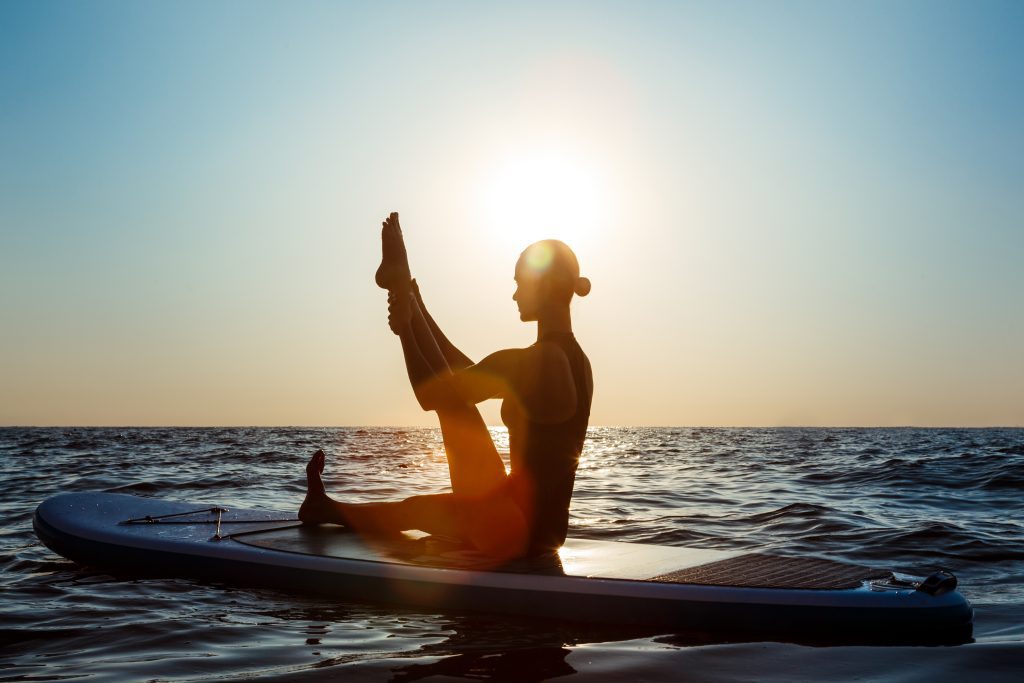
Instructions:
1: Sit on the paddleboard with your knees bent and feet flat on the deck.
2: Lean back slightly, lift your feet off the board, and balance on your sitting bones.
3: Straighten your legs to a 45-degree angle while keeping your spine long and your chest lifted.
4: Extend your arms forward, parallel to the ground.
7. Plank Pose (Phalakasana)
Plank Pose is a classic pose that targets the core, arms, and shoulders. Begin by placing your hands on the paddleboard, shoulder-width apart, and extend your legs behind you, resting on your toes. Keep your body in a straight line from head to heels, engage your core, and avoid sagging or lifting your hips. Hold this pose and feel your muscles working as you embrace the gentle sway of the water beneath you.

Instructions:
1: Place your hands on the paddleboard, shoulder-width apart, and extend your legs behind you, resting on your toes.
2: Keep your body in a straight line from head to heels, engage your core, and avoid sagging or lifting your hips.
8. Dolphin Pose (Ardha Pincha Mayurasana)
Dolphin Pose is a variation of Downward Facing Dog that strengthens the shoulders and core. Start on all fours with your forearms on the paddleboard, shoulder-width apart. Tuck your toes, lift your hips, and straighten your legs, coming into an inverted V shape. Press your forearms firmly into the board and relax your head and neck. Engage your core, press your heels down towards the water, and enjoy the soothing rhythm of the ocean as you hold this pose.

Photo Credit: Stretcheveryday.yoga
Instructions:
1: Start on all fours with your forearms on the paddleboard, shoulder-width apart.
2: Tuck your toes, lift your hips, and straighten your legs, coming into an inverted V shape.
3: Press your forearms firmly into the board and relax your head and neck.
9. Downward Facing Dog Pose (Adho Mukha Svanasana)
Downward facing dog is the first pose that most aspiring yogi’s ever learn. And it’s a great pose to use on a paddleboard. It stretches and widens the hamstrings, calves and the achilles tendon. The head is below your heart so you have the added benefits of increasing the blood flow in your body, and it also reduces pain in your neck and back. Take this pose and feel your stress melt away.
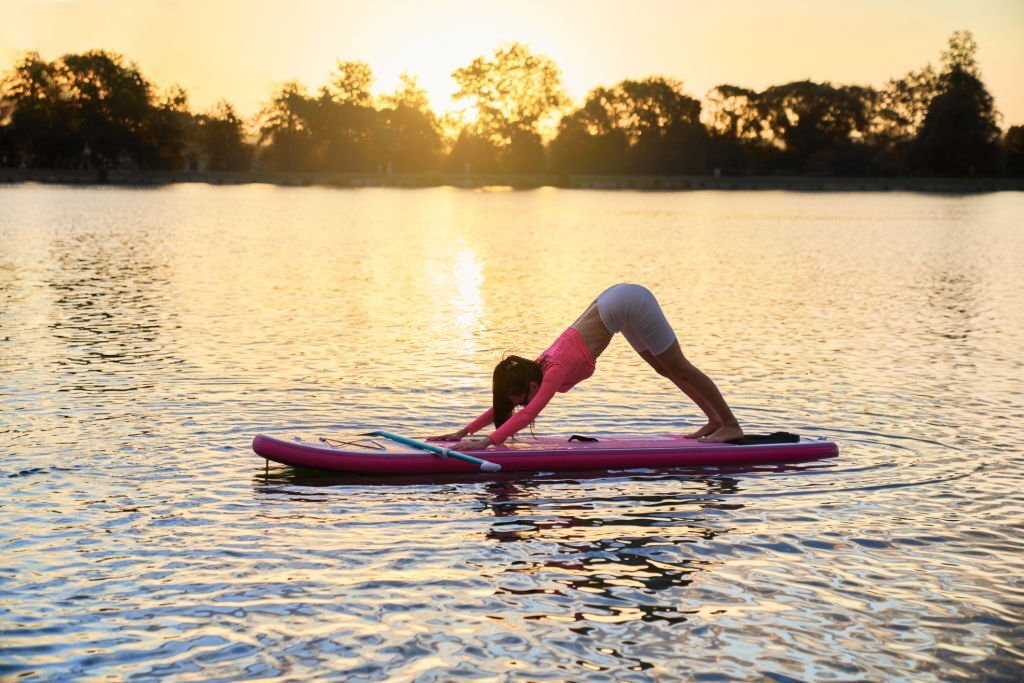
Instructions:
1: Start on all fours with your hands slightly in front of your shoulders.
2: Tuck your toes, lift your hips up and back, and straighten your legs, creating an inverted V shape.
3: Press your hands firmly into the board and relax your head and neck.
10. Upward Facing Dog Pose (Urdhva Mukha Svanasana)
Upward Facing Dog Pose stretches the front body and strengthens the arms and back. Begin by lying face down on the paddleboard with your hands placed alongside your ribs. Press into your palms, lift your chest off the board, and straighten your arms. Keep your legs engaged and the tops of your feet pressing into the board. Gaze forward and feel the openness and expansiveness of this pose as you embrace the water element.
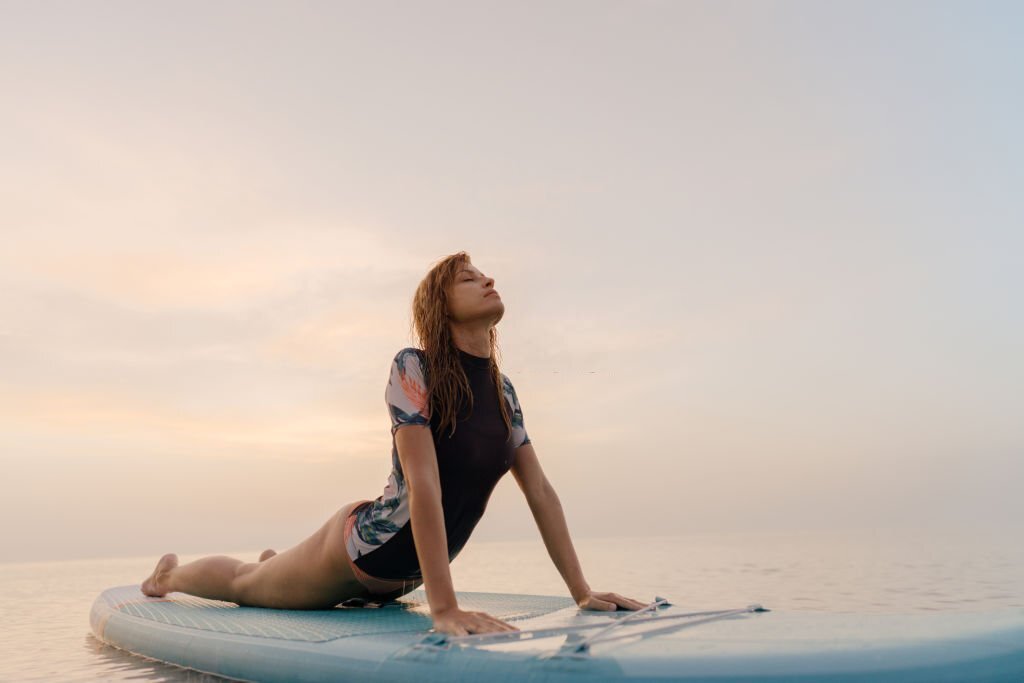
Instructions:
1: Lie face down on the paddleboard with your hands placed alongside your ribs.
2: Press into your palms, lift your chest off the board, and straighten your arms.
3: Keep your legs engaged and the tops of your feet pressing into the board.
Yoga Poses for Relaxation and Rejuvenation
11. Child’s Pose (Balasana)
Child’s Pose is a resting pose that promotes relaxation and helps release tension in the back, shoulders, and hips. Start by sitting on your heels and slowly lower your forehead to the paddleboard. Extend your arms forward or rest them alongside your body. Allow your body to surrender to the support of the board and let go of any tension. Take deep breaths and enjoy the tranquility of this nurturing pose.

Instructions:
1: Sit on your heels and slowly lower your forehead to the paddleboard.
2: Extend your arms forward or rest them alongside your body.
3: Allow your body to surrender to the support of the board and let go of any tension.
12. Cat-Cow Pose (Marjaryasana-Bitilasana)
Cat-Cow Pose is a gentle flow that warms up the spine and releases tension in the back and neck. Begin on all fours, with your wrists under your shoulders and your knees under your hips. Inhale, arch your back, lift your chest and tailbone, and gaze forward (Cow Pose). Exhale, round your spine, tuck your chin to your chest, and draw your belly button in (Cat Pose). Flow between these two poses, synchronizing your movements with your breath. You can even do a variation of the pose like the image below if you’re more advanced.
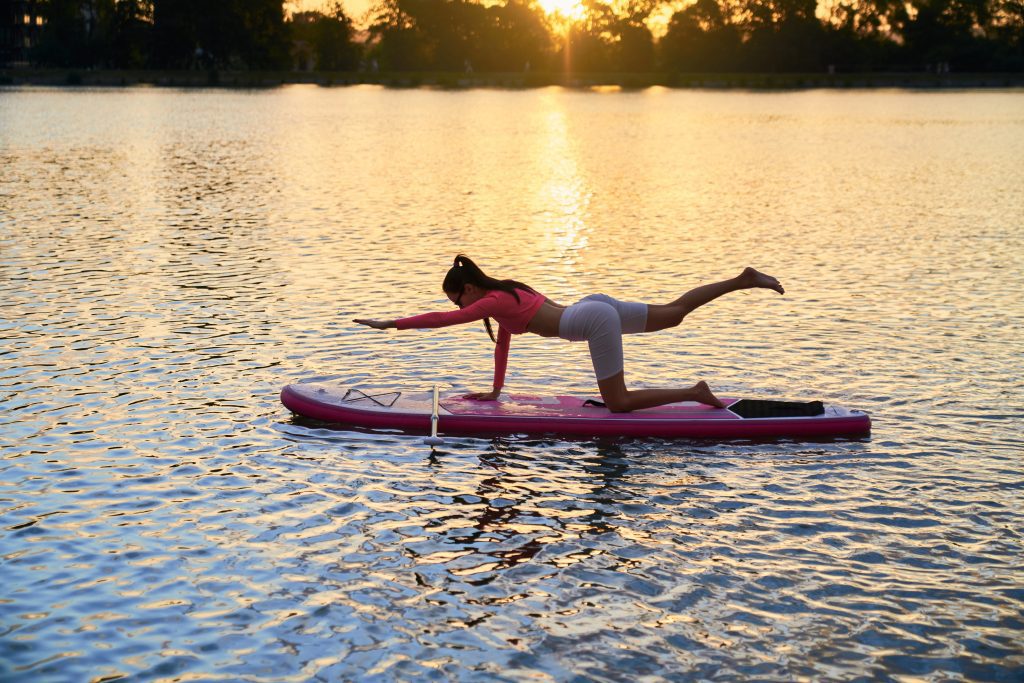
Instructions:
1: Start on all fours, with your wrists under your shoulders and your knees under your hips.
2: Inhale, arch your back, lift your chest and tailbone, and gaze forward (Cow Pose).
3: Exhale, round your spine, tuck your chin to your chest, and draw your belly button in (Cat Pose).
13. Bridge Pose (Setu Bandhasana)
Bridge pose is an energizing and invigorating pose that stimulates the nervous system and energizes the body. And this makes it an excellent pose to practice on a paddleboard. The combination of the gentle sway of the water and the pose’s uplifting nature can create a revitalizing and invigorating experience. Lie on your back and lift your hips to the sky to relieve tension and fatigue in your back. And breathe deep to open your lungs and calm a racing mind.

Instructions:
1: Lie on your back with your knees bent and feet flat on the paddleboard, hip-width apart.
2: Press your feet firmly into the board, engage your glutes, and lift your hips toward the sky.
3: Interlace your fingers beneath your body, and roll your shoulders underneath you.
14.Seated Forward Bend (Paschimottanasana)
Seated Forward Bend stretches the entire back body, promotes relaxation, and calms the mind. Sit on the paddleboard with your legs extended forward. Inhale, lengthen your spine, and as you exhale, hinge at the hips and fold forward, reaching for your feet or ankles. Keep your spine straight and avoid rounding your back. Allow your head and neck to relax. Breathe deeply and let go of any tension with each exhale.
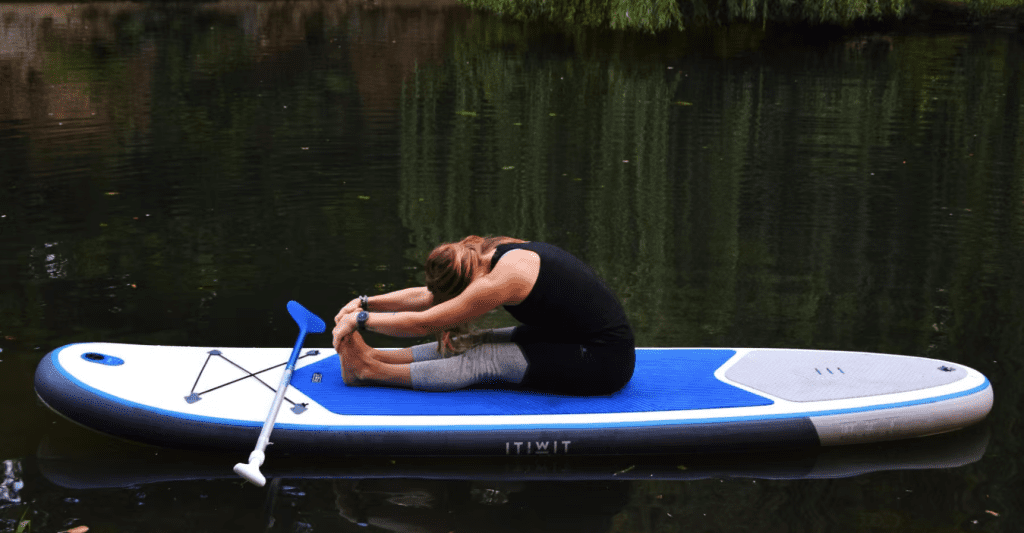
Photo Credit: itiwit.co.uk
Instructions:
1: Sit on the paddleboard with your legs extended forward.
2: Inhale, lengthen your spine, and as you exhale, hinge at the hips and fold forward, reaching for your feet or ankles.
3: Keep your spine straight and avoid rounding your back.
15. Corpse Pose (Savasana)
Corpse Pose is the final relaxation pose that allows the body to integrate and rejuvenate. Lie flat on your back on the paddleboard, with your arms resting alongside your body, palms facing up. Close your eyes and allow your body to completely surrender to the support of the board. Release any tension and let go of any thoughts or worries. Focus on your breath, and with each exhale, feel yourself becoming more relaxed and at peace.
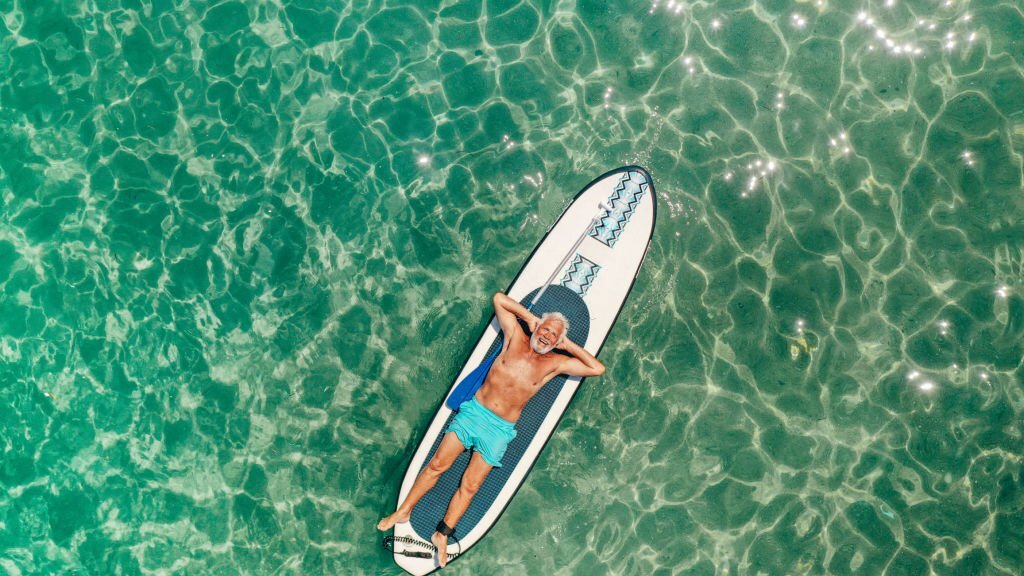
Instructions:
1: Lie flat on your back on the paddleboard, with your arms resting alongside your body, palms facing up.
2: Close your eyes and allow your body to completely surrender to the support of the board.
3: Release any tension and let go of any thoughts or worries.
Tips for Maintaining Balance and Stability During Yoga on a Paddleboard
Practicing yoga on a paddleboard requires a unique set of skills to maintain balance and stability. Here are some tips to help you stay grounded and centered on the board:
Engage your core: By actively engaging your abdominal muscles, you create a strong and stable center, which helps you maintain balance on the paddleboard.
Soften your gaze: Instead of fixating your eyes on a single point, soften your gaze and broaden your field of vision. This allows you to be more aware of your surroundings and react to the movement of the water.
Use your breath: Focus on deep, steady breaths. Your breath acts as an anchor, helping you stay present and centered, even when the paddleboard moves beneath you.
Embrace the wobbles: Accept that wobbling and minor adjustments are part of the experience. Don’t get discouraged if you lose your balance. Instead, use it as an opportunity to cultivate patience and resilience.
Take it slow: Start with basic poses and gradually progress to more challenging ones as your balance and confidence improve. Respect your body’s limits and listen to its signals.
Benefits of Practicing Yoga on a Paddleboard
Paddleboard yoga offers a wide range of benefits for both the body and mind. Here are some key advantages:
Core strength and stability: The unstable surface of the paddleboard engages your core muscles more intensively, leading to improved strength and stability.
Balance and coordination: Balancing on the water requires constant adjustments, enhancing your proprioception, balance, and coordination skills.
Connection with nature: Being surrounded by nature, feeling the gentle movement of the water, and breathing in fresh air deepens your connection with the elements and enhances the overall yoga experience.
Mindfulness and focus: The presence required to stay balanced on the paddleboard cultivates mindfulness and a deeper sense of focus. It allows you to be fully present in the moment and let go of distractions.
Stress reduction: Engaging in yoga on a paddleboard combines the benefits of being in nature, practicing yoga, and enjoying the water, all of which contribute to stress reduction and a sense of calm.
My Favorite Paddleboards To Do Yoga On:
* Roc Inflatable SUP (Best Budget SUP OF 2025)

Where To Buy: Amazon
Why I Love It:
– Has a large non-slip comfort deck that can easily fit you with space to move
– Extremely high quality material that won’t get scuffed and damaged.
– 16.25 inch width makes it very stable
– It looks great!
* Portal 11’6″ Paddle Board (Best Overall SUP)
Where To Buy: Amazon
Why I Love It:
– 33 inch width gives it amazing width and stability.
– It has a depth of 6 inches that increases the weight capacity of the board to over 300lbs without sacrificing stability.
– This SUP has ample space along with a non-slip deck pad that is perfect for yoga
– It comes with everything included and a 2 year warranty.


Where To Buy: Amazon
Why I Love It:
– This board is extra long and extra wide which is ideal for beginners (because it’s super stable)
– This board was designed for yoga so it’s super stable
– It comes with everything included and a 1 year warranty.
| Here are a few more great paddleboards for beginners: 7 Incredible Beginner Paddleboards To Buy In 2025 On A Budget |
Conclusion
Practicing yoga on a paddleboard adds a thrilling and rejuvenating dimension to both yoga and paddleboarding. It challenges your physical abilities, cultivates mindfulness, and allows you to immerse yourself in the beauty of nature. By incorporating the 15 yoga poses mentioned in this article, you can strengthen your body, improve balance, and find inner peace on the water. So grab your paddleboard, venture out into the calm waters, and embark on a journey of self-discovery and tranquility.
| Looking for insider guides to some amazing paddle boarding locations? Check the Paddleboard Insiders Location Guides |
FAQs
Can anyone practice yoga on a paddleboard, or is it only for experienced yogis?
Both beginners and experienced yogis can practice yoga on a paddleboard. However, it’s recommended to have a basic understanding of both paddleboarding and yoga before attempting yoga poses on a paddleboard. Starting with simple poses and gradually progressing will help build confidence and stability.
Do I need any special equipment for yoga on a paddleboard?
Yes, you’ll need a stable paddleboard designed for yoga or with a wide deck for better balance. Additionally, a non-slip deck pad, an adjustable paddle, and appropriate attire are essential. It’s also a good idea to have a waterproof bag or container for your belongings.
How do I choose the right paddleboard for yoga?
Look for paddleboards specifically designed for yoga, with a wider and more stable deck. Consider the length, width, and volume of the board based on your height, weight, and skill level. Test different boards if possible to find the one that feels most comfortable and suits your needs.

What if I fall into the water while practicing yoga on a paddleboard?
Falling into the water is part of the experience and should be embraced with a sense of humor. It’s recommended to practice in calm waters and wear a life jacket for added safety. Falling can be refreshing and part of the fun. Just climb back onto your board, take a deep breath, and continue your practice.
Can I practice yoga on a paddleboard in any body of water?
While you can practice yoga on a paddleboard in various bodies of water, it’s important to choose calm and safe environments. Avoid strong currents, rough waves, or areas with boat traffic. Lakes, calm rivers, and protected bays are usually suitable for paddleboard yoga. Always prioritize your safety and choose locations that match your skill level.
